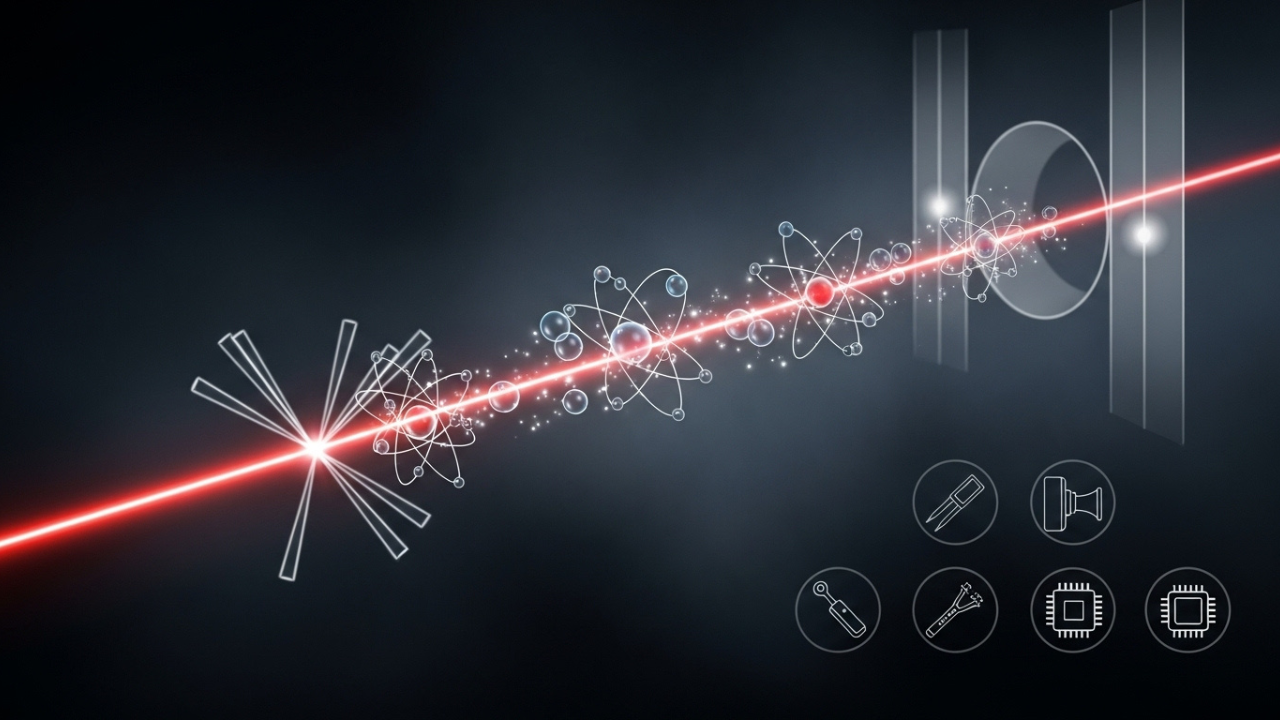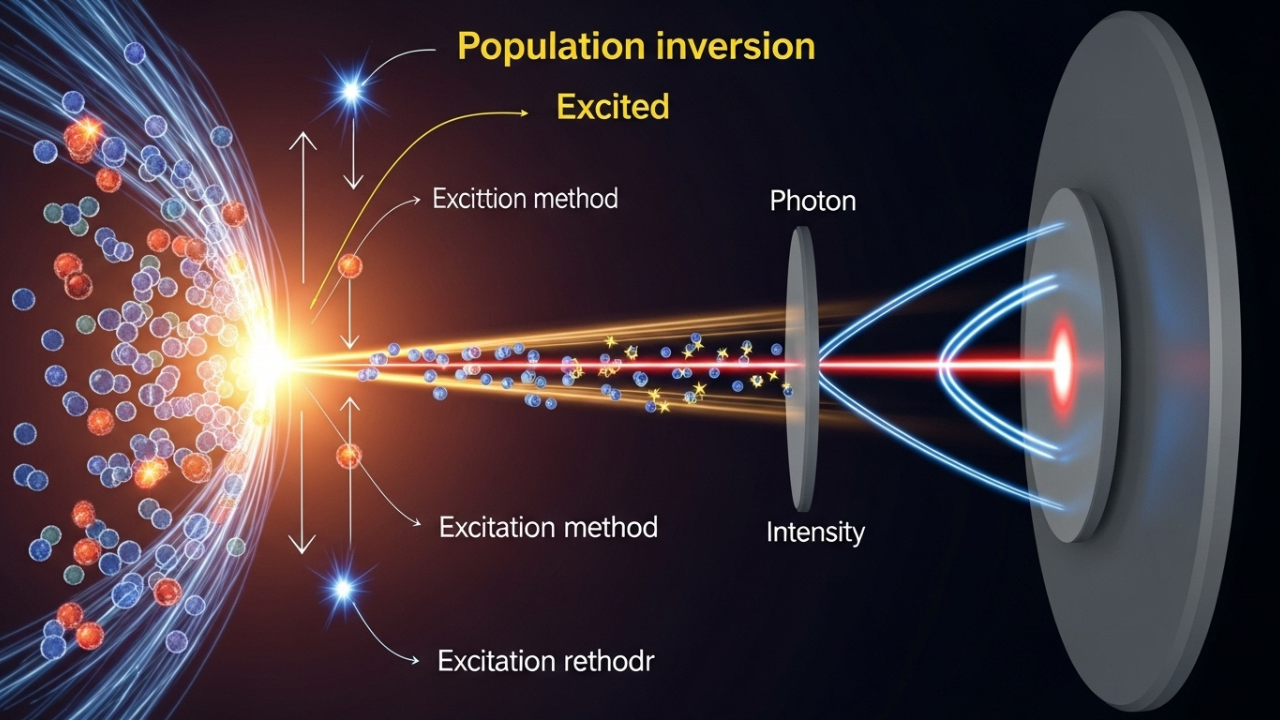You may not remember the first time you saw a laser, but I do. It was in school, during a presentation, when a tiny red dot danced across the whiteboard like a little beam of magic.
It wasn’t like the flashlight I had at home. It didn’t scatter. It didn’t flicker. It was clean, straight, and strangely powerful.
The teacher called it a laser, but never really explained how something so simple-looking could produce such a perfect beam.
Years later, I learned that the real answer to how lasers work lives deep inside the world of atoms, energy, and something far less visible—quantum theory. If you’ve ever wondered what makes a laser behave the way it does, you’re about to learn it through the eyes of someone who once thought lasers were science fiction.
Key Takeaways
- Lasers work because quantum theory allows electrons to jump between energy levels and release identical photons.
- Stimulated emission causes these photons to multiply, creating light that is coherent, monochromatic, and directional.
- The process requires a prepared atomic environment called population inversion and a laser cavity to amplify light.
- Different types of lasers use various materials, but they all rely on the same quantum principles.
- Understanding how lasers work helps connect quantum mechanics to real-life technology and future innovation.
A World Where Atoms Don’t Behave Like We Expect
The more you study nature, the stranger it gets. Atoms, which we often imagine as tiny solar systems, don’t actually work like that. Their electrons don’t orbit in smooth circles. Instead, they jump between energy levels—discrete, allowed positions where each jump in or out releases or absorbs a specific amount of energy. That idea may sound abstract, but it’s the first piece of understanding how lasers work. In the quantum world, nothing happens gradually. Electrons move in leaps. Energy comes in packets. And when an excited atom calms down, it releases its extra energy as light. Not just any light, but a light particle with an exact color and direction: a photon.
The photons released this way are what we need to understand lasers. The difference between a regular light source and a laser isn’t about how much light is made, but about how that light is structured. You see, in a normal bulb, electrons are excited and drop back down at random. The photons they emit are scattered, mixed, and uncoordinated. But in a laser, we make those atoms behave differently. Instead of chaos, we get cooperation. That switch—from randomness to structure—is guided entirely by quantum theory.
The Magic Happens When Photons Start Copying Each Other
In 1917, Einstein made a prediction that took decades to put into action; he proposed that one photon might be able to stimulate an excited atom, making it emit a second, identical photon in color, direction, and even phase. This process is called stimulated emission, which is the fundamental basis for the operation of lasers. LASER is an acronym for Light Amplification by Stimulated Emission of Radiation. Once you understand this, you are halfway there in grasping the entire system.
Picture a scenario in which a photon strikes an excited atom. Instead of merely bouncing back, it incites the atom to eject energy as a photon that is identical in appearance. In such cases, there are now two identical photons. If both photons are aimed at two more excited atoms, there are now four photons. In this case, the result resembles a chain reaction; only this time there is no explosion, but rather, perfect harmony. This cascade effect, driven by quantum predictability, is what transforms a small number of excited atoms into a coherent light beam.
The Secret Is Preparing the Atoms to Respond
This does not occur spontaneously. In order to initiate this cascade of stimulated emissions, the atoms must have the condition in which more of them are ‘excited’ than ‘relaxed.’ This condition is ‘population inversion.’ This is not normal condition because atoms at rest do not wish to stay ‘excited’ for a long period of time. In order to create population inversion, energy needs to be pumped into the system.
The technique differs from one type of laser to another. In gas lasers, electric currents are used. In solid-state lasers, a flash of light will do the trick. Regardless of the method used, the objective is identical: shift the atoms in most abundance to a higher energy state so that they can become involved in the photon-duplication action once they are set off.
Picture a theater full of people absolutely silent and sitting down ready for a performance to start. Coherence in the photon world is liks meticulous synchronization of individual breaths as they await a singular cue to set off, resulting in a intelligent sequence of motions in which each participant is perfectly in-sync. That specific coherence is fundamental for maintaining the pristine shape of a laser beam.
The Laser Cavity: Where Photons Bounce and Multiply
An array of materials and apparatus such as mirrors and photonic compare managed to construct a structure of oscillating light which is a laser, relying heavily on an active medium made of atoms whose appendages emit and absorb light. The cavity contains various technologies such as a pulse circuit, laser switches, shunt switches, and ultimately a gain medium such as an excition, crystal, or other methods.
All photons that are parallel to the cavity direction will either scatter or die, while the remaining ones will continue to stay in sync with the photonic timing and geometry. These cavity photons in perfect alignment will eventually become stronger and stronger until they are so full they explode within the matching cavity and are forced to escape through the partially reflective mirror, which results in a laser beam.
The beam itself is narrow because a minute portion of the angles and wavelengths are permitted to survive. Survive because the photons are in full phase which is why they emit so intensely. Each surviving photon’s energy level needs to be specifically defined, hence monchromatic laser beams. And all these results require the laws of quantum physics.
Why Lasers Are So Different From Ordinary Light
To comprehend what distinguishes laser light from other types of light, it is important to first analyze some aspects of light you might be familiar with. The sun’s light has every color ranging from infrared to ultraviolet. Moreover, its photons stem from innumerable processes taking place within a star’s plasma. Similarly to a light bulb, which has photons being emitted at random from an array of processes, light is emitted from a broad spectrum. All these lights fade or spread. While they may fill the room, they do not travel in a neat manner.
Coherent Light is what we refer to as laser light. Each photon is identical in relation to the next one and matches in terms of wavelength as well as direction. Unlike in a chaotic setting, they are not just similar in behavior, but identical. This coherence is the reason laser beams can stay narrow over great distances, can focus into sharp points and can deliver high energy in small areas. Whether it is a surgical laser that cuts tissue with insane precision or a pointer used in a lecture, the result is the same; photons marching in impeccable lockstep.
The limits of classical mechanics is the inability to explain stimulated emmisions, coherence, or coherent predictions. Hence a proper model of a laser can only be attained by accepting the quantum nature of energy levels and photons. Subsequently, feeble attempts of comprehending a laser without utilizing quantum theory renders the explanation void as it completely lacks structure, leading to a pathetic analogy of attempting to describe melodies with an alphabet.
How Different Lasers Use the Same Quantum Foundations
Quantum foundations serve all types of lasers uniformly, although varying materials and energy sources are employed. In the case of a helium-neon laser, gas molecules are electrically excited, while a solid crystal in a ruby laser is atomically excited with intense light pumps.
DVD player and fiber optic communication lasers utilize semiconductors, which function as electron conduits and guide them to pre-defined energy state transitions. Irrespective of the type used, the fundamental behavior remains constant. Energy absorption by atoms, transitioning to an exited state, followed by controlled, amplified photon emission in cascade.
It is almost poetic to think that this micromovement of atoms and light could have such enormous implications. With the use of lasers, bloodless surgical procedures can be performed by doctors. Lasers help guide spacecrafts and airplanes. They also scan groceries, transmit data across oceans, and etch patterns on silicon chips. At the center of all thesephenomena is a quantum principle that Einstein predicted before the first working model was built. The effectiveness of theory is in the manner it helps impact the world, even before the exact plan of use has been ascertained.
Why Students Should Care About Quantum Lasers
Everything explained so far seems to be far detached from the quote or the learning of a student. One does not require to be building lasers, or working with optics. However, learning the working of lasers through quantum theory steps into the realm of insight, where abstract science changes into usable technology. It proves that the world of quantum mechanics is not simply strange, but also extremely practical. It is the force propelling modern medicine’s precision instruments, city communication networks, and computing’s prospective advancements.
It shows us that we do not subdue nature to control the world rather, we understand it on the deepest level possible. It explains to us that atom obeying does not give rise to lasers; rather, us learning how to work with atoms gives rise to lasers. Such a thought is not only scientific; it is a human thought. It is learning, adjusting, and applying knowledge towards ways that improves life.
If you wish to look into more advanced concepts like quantum encryption, Bose–Einstein condensates, and even quantum teleportation, then starting from here is more beneficial. Lasers serve as one of the primary technologies that make quantum theory feel practical, visible, and real. They serve as the pathway to everything else.
My Opinion
At one time, the creation of lenses was regarded as a problem that was awaiting issues for which it could be useful. However, as engineers and scientists undertook more and more explorative activities, they rushed to develop other uses for its orderly operation. Such activities include measuring distances with extreme accuracy as well as carrying out eye surgeries which correct vision within minutes. Lasers turned out to be effective over and over again.
The most important task lasers had to deal with involves the age of quantum computing and secure quantum communications. At this point in time, these devices require each technologies mentioned above. Initially, lasers are used for cooling atoms to nearly Absolute zero, fixing ions in place, as well as moving qubits through optic fibers. In today’s world, which continues becoming advanced with quantum elements, while lasers for cooling and controlling are a perfect blend of powerful theory and stable application.






























Leave a Reply
View Comments